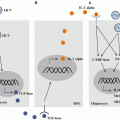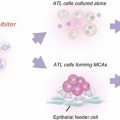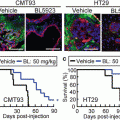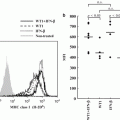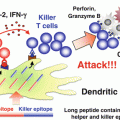Year
Author
No. of patients
Setting for DCs
Responses
2002
Ladhams et al.
2
GM-CSF/IL-4 DC + tumor
1/2 inhibition of tumor growth
2003
Iwashita et al.
10
GM-CSF/IL-4 DC + tumor lysate + TNF-α + KLH
1/10 MR
2003
Stift et al.
2
GM-CSF/IL-4 DC + tumor lysate + TNF-α + IL-2
No PR or CR
2005
Mazzolini et al.
8
GM-CSF/IL-4 DC + tumor + adenovirus IL-12
2/8 SD
2005
Lee et al.
31
DC + tumor lysate
Improved survival
2005
Chi et al.
14
Radiotherapy + DC
Immune response
2006
Butterfield et al.
10
DC with AFP peptides
No PR or CR
2007
Nakamoto et al.
10
TAE + GM-CSF/IL-4 DC
Immune response
2009
Palmer et al.
35
GM-CSF/IL-4 DC + HepG2 cells lysate + TNF-α
25 patients were assessed, 1/25 PR and 6/25 SD
2010
Nakamoto et al.
13
TAE + GM-CSF/IL-4 DC + OK432
Prolonged recurrence-free survival
2011
Zhou et al.
10
PMWA + GM-CSF/IL-4 DC + CIK + CTL
Immune response
2011
Qiu et al.
9
GM-CSF/IL-4 DC + TNF-α + tumor lysate contained α-Gal epitope
3/9 PR and 3/9 SD
2012
Tada et al.
5
GM-CSF/IL-4 DC + recombinant protein (AFP, GPC3, MAGE-1) + cytokine cocktail
1/5 SD
2012
Ansary et al.
15
GM-CSF/IL-4 DC + HepG2 cells lysate
2/15 PR and 9/15 SD
10.3 Peptide Vaccine
In addition to DC therapy, we also attempted to develop a peptide vaccine as an immunotherapy for HCC. The first step to establish the treatment is identification of TAA expressed in HCC. Since HCC is complicated by background liver damage in many cases, the establishment of a safe and effective peptide vaccine for HCC depends on whether an immune response killing only tumor cells without injuring normal hepatocytes can be induced, for which it is necessary to discover HCC-specific TAA with high-level immunogenicity. Generally, HCC had not been considered as an ‘ immunogenic’ tumor, but previous studies reported that the risk of recurrence after treatment was low and the outcome was favorable in HCC patients with many infiltrating lymphocytes in the tumor, suggesting that anti-tumor immunity is also present and tumor progression is inhibited through an immunological mechanism in HCC patients (Wada et al. 1998). Actually, including our data, many TAAs and their CTL epitope expressed in HCC have been discovered over the past 10–15 years (Butterfield et al. 2001; Zerbini et al. 2004; Korangy et al. 2004; Komori et al. 2006; Mizukoshi et al. 2006a, b).
To date, however, there have been no reported studies of T cell responses to previously identified TAAs or their epitopes being measured simultaneously and comparatively in a number of HCC patients. Therefore, to identify suitable epitopes for peptide vaccine, we performed a simultaneous and comparative analysis of immune responses to 27 different CTL epitopes derived from 14 previously reported TAAs in the PBMCs of 31 HCC patients (Mizukoshi et al. 2011). In this study, we made the following findings and selected suitable epitopes: (1) the TAAs consisting of cyclophilin B, squamous cell carcinoma antigen recognized by T cells (SART) 2, SART3, p53, MRP3, AFP, and hTERT were frequently recognized by T cells and these TAA-derived peptides were capable of generating peptide-specific CTLs in HCC patients, which suggested that these TAAs are immunogenic; and (2) HCC treatments enhanced TAA-specific immune responses with an increased number of memory T cells and induced de novo T cell responses.
On the basis of the above data, we are now conducting several clinical trials on HCC patients using hTERT-, AFP-, MRP3-, SART2-, and SART3-derived peptides. In the clinical trial of hTERT-derived peptide vaccine, HCC patients treated using RFA were enrolled. The peptide was administered emulsified with incomplete Freund’s adjuvant by subcutaneous immunization three times biweekly. The maximum toxicity observed was grade 2 according to the Common Terminology Criteria and mainly consisted of skin reactions at the vaccination sites. Several immunological assays revealed that the vaccination induced hTERT-specific immunity. Although the HCC recurrence-free survival time after RFA did not differ between patients without vaccination and those with the hTERT-specific immune response after vaccination, the recurrence rate in patients with vaccination was reduced beyond 1 year after RFA.
In the clinical trial of AFP-derived peptide vaccine, we enrolled advanced HCC patients who had been treated by standard therapy including surgical resection, RFA, TACE, chemotherapy, and sorafenib but did not show a clinical benefit. The method of vaccination was almost the same as that for hTERT-derived peptide vaccine but it was continued until the confirmation of tumor progression. The observed toxicity mainly consisted of skin reactions at the vaccination sites, and severe adverse events were not observed. To date, we have observed one patient with complete response (CR) and one patient with long-term stable disease (SD). AFP-specific immune responses were observed in these two patients using several immunological assays. These results are encouraging for the possibility of using peptide vaccines for HCC.
Several studies have been reported regarding an immunotherapy using peptide vaccines for HCC (Table 10.2) (Butterfield et al. 2003; Greten et al. 2010a; Sawada et al. 2012). A clinical trial of HCC immunotherapy using AFP-derived peptides has been performed, in which AFP-specific CTL increased after treatment in six of six HCC patients. In addition to AFP, clinical trials of vaccines comprised of the CTL epitopes of hTERT and glypican-3 (GPC3) have been performed in HCC patients (Greten et al. 2010a, b; Sawada et al. 2012). hTERT-derived peptide vaccine was administered in combination with cyclophosphamide to 40 patients with advanced HCC, but no potentiation of immune reactions to the peptide was observed, and, regarding the anti-tumor effect, no patient showed a CR or partial response (PR) (Greten et al. 2010a, b). In the clinical trial of GPC3-derived peptide, vaccine was administered to 33 advanced HCC patients (Sawada et al. 2012). A PR was noted in one patient, and an effect maintaining an SD condition for more than 2 months was noted in 19 patients. In addition, tumor necrosis and size reduction were noted in four of the 19 patients in whom the disease condition was stabilized, supporting the possibility of using TAA-targeting immunotherapy for HCC. No serious adverse events occurred in AFP-, hTERT-, or GPC3-targeted immunotherapy, confirming that immunotherapy by peptide vaccine can be safely applied in advanced HCC patients with reduced hepatic reserve capacity.
Table 10.2
Clinical trials of peptide vaccines for hepatocellular carcinoma
Year | Author | No. of patients | Setting for peptides | Responses |
|---|---|---|---|---|
2003 | Butterfield et al. | 6 | AFP-derived peptides + Montanide adjuvant, HLA-A2 | No PR or CR |
2010 | Greten et al. | 40 | hTERT-derived peptides + cyclophosphamide + GM-CSF | No PR or CR |
2012 | Sawada et al. | 33 | GPC3-derived peptides + Montanide™ adjuvant, HLA-A24 and A2 | 1/33 PR and 19/33 SD |
2012 | Mizukoshi et al. | 12 | SART2-derived peptides + Montanide™ adjuvant, HLA-A24 | Immune response |
2012 | Mizukoshi et al.a | 14 | hTERT-derived peptides + Montanide™ adjuvant, HLA-A24 | Prolonged recurrence-free survival and immune response |
2012
Stay updated, free articles. Join our Telegram channel
Full access? Get Clinical Tree
 Get Clinical Tree app for offline access
Get Clinical Tree app for offline access

|

